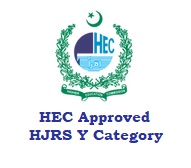A cross-sectional study of the COVID-19 prevalence in Dir Lower, Pakistan
DOI:
https://doi.org/10.47264/idea.nasij/3.1.5Keywords:
SARS-CoV-2, Coronavirus, RT-PCR, Corona patients, seroprevalence, molecular analysis, epidemiologyAbstract
The article investigates the prevalence of COVID-19 in the district Dir Lower, Khyber Pakhtunkhwa, Pakistan. A cross-sectional epidemiological study was conducted in January-June 2020. Samples were taken from suspected patients who visited the District Headquarters Hospital, Timergara (DHQHT), Dir (Lower). All the experimental work was conducted at the DHQHT pathology laboratory. The Real-Time Polymerase Chain Reaction (RT-PCR) was used for testing. A P-value less than 0.05 was considered statistically significant. This study examines 2718 individuals. COVID-19 confirmed cases totalled 1125 (41.39 %), with 10 fatalities (0.5 %). Males (829) had a higher prevalence of illness than females (296), with a p-value of (0.76). Positive cases were most prevalent among those aged 31–40 years (26.84 %), followed by those aged 41–50 years (15.02 %), those aged 0–10 years (3.91%), those aged 11–20 years (9.51%) and those aged 21–30 years (21.24%). Most of the COVID-19 cases were found in the tehsils of Timergara (534) and Lal Qila (118). The study's findings indicate a high rate of positive cases and a low mortality rate. This study will aid researchers, doctors and policymakers in their efforts to contain or eliminate the spread of COVID-19 in the study area.
References
Abid, K., Bari, Y. A., Younas, M., Javaid, S. T., & Imran, A. (2020). Progress of COVID-19 epidemic in Pakistan. Asia Pacific Journal of Public Health, 32(4), 154-156. https://doi.org/10.1177/1010539520927259
Ahmad, T., Haroon, M. B., & Hui, J. (2020). Coronavirus disease 2019 (COVID-19) pandemic and economic impact. Pakistan Journal of Medical Sciences, 36(19), 70-73. https://doi.org/10.12669%2Fpjms.36.COVID19-S4.2638
Ahmad, T., Khan, M., Haroon, T. H. M., Nasir, S., Hui, J., Bonilla-Aldana. D. K., & Rodriguez-Morales, A. J. (2020). COVID-19: Zoonotic aspects. Travel Medicine and Infectious Disease, 36, 16-17. https://doi.org/10.1016%2Fj.tmaid.2020.101607
Ahmed, S. N., Rehman, S. U., & Khan, S. M. (2021). Online graded assessment of Saudi EFL learners during the Covid-19 pandemic: a successful implication of TAM. Liberal Arts and Social Sciences International Journal (LASSIJ), 5(1), 667–685. https://doi.org/10.47264/idea.lassij/5.1.43
Ali, I., Shah, S. M., Khan, A., Amin, S., & Lal, A. (2021). Incidence and clinical characteristics of the novel coronavirus disease (COVID-19) in district Swat. Journal of Saidu Medical College, Swat, 11(2), 114-117. https://doi.org/10.52206/jsmc.2021.11.2.114-117
Andersen, K. G., Rambaut, A., Lipkin, W. I., Holmes, E. C., & Garry, R. F. (2020). The proximal origin of SARS-CoV-2. Nature Medicine, 26(4), 450-452. https://doi.org/10.1038/s41591-020-0820-9
Anwar, F., Zubair, M., Shah, M., Ahmad, S., Mehmood, M., Bakht, S., ... & Shah, O. U. (2021). Molecular epidemiology of SARS-COV-2 in Mardan, Khyber Pakhtunkhwa Pakistan: a real world clinical experience. Bioscience Research, 18(2), 1608-1613. https://search.bvsalud.org/global-literature-on-novel-coronavirus-2019-ncov/resource/en/covidwho-1411152
Aslam, T., Rizvi, S. M. A. S., & Ahmad, J. (2020). Virtual learning strategies during Covid-19: a case study of the University of Lahore, Pakistan. Liberal Arts and Social Sciences International Journal (LASSIJ), 4(2), 427–441. https://doi.org/10.47264/idea.lassij/4.2.33
CDCP. (2020). COVID: what to do if you are sick. Centres for Disease Control and Prevention.
Ejaz, R., Ashraf, M. T., Qadeer, S., Irfan, M., Azam, A., Butt, S., & Bibi, S. (2021). Gender-based incidence, recovery period and mortality rate of COVID-19 among the population of district Attock, Pakistan. Brazilian Journal of Biology, 83, 1-7. https://doi.org/10.1590/1519-6984.249125
Harrison, A.G., Lin, T., & Wang, P. (2020). Mechanisms of SARS-CoV-2 transmission and pathogenesis. Trends in Immunology, 41(12), 1100-1115. https://doi.org/10.1016/j.it.2020.10.004
Hu, B., Guo, H., Zhou, P., & Shi, Z. L. (2021). Characteristics of SARS-CoV-2 and COVID-19. Nature Reviews Microbiology, 19(3), 141-154. https://doi.org/10.1038/s41579-020-00459-7
Jan, A., Rahman, K. U., & Khan, I. U. (2020). Socio-economic and psychological impacts of Covid-19: a case study of quarantined village Ziarat Talash in Dir Lower, Pakistan. Liberal Arts and Social Sciences International Journal (LASSIJ), 4(2), 1–10. https://doi.org/10.47264/idea.lassij/4.2.1
Khan, M., Adil, S. F., Alkhathlan, H. Z., Tahir, M. N., Saif, S., Khan, M., & Khan, S. T. (2021). COVID-19: a global challenge with old history, epidemiology and progress. Molecules, 26(1), 39. https://doi.org/10.3390/molecules26010039
Letko, M., Marzi, A., & Munster, V. (2020). Functional assessment of cell entry and receptor usage for SARS-CoV-2 and other lineage B betacoronaviruses. Nature Microbiology, 5(4), 562-569. https://doi.org/10.1038/s41564-020-0688-y
Li, C., Zhao, C., Bao, J., Tang, B., Wang, Y., & Gu, B. (2020). Laboratory diagnosis of coronavirus disease-2019 (COVID-19). Clinica Chimica Acta; International Journal of Clinical Chemistry, 5(10), 35. https://doi.org/10.1016/j.cca.2020.06.045
Rehman, M., Tauseef, I., Aalia, B., Shah, S. H., Junaid, M., & Haleem, K. S. (2020). Therapeutic and vaccine strategies against SARS-CoV-2. Future Virology, 15(7), 471- 482. https://doi.org/10.2217/fvl-2020-0137
Saeed, F., Zubair, M., Jawad, M., Ullah, F., Uddin, M. N., Siddique, U., & Rizwan, A. (2021). Epidemiological, clinical characteristics and possible treatment of coronavirus disease (Covid-19) during early situation in population of district Karak, Khyber Pakhtunkhwa, Pakistan. Pak-Euro Journal of Medical and Life Sciences, 4(4), 337-346. https://doi.org/10.31580/pjmls.v4i4.2339
Verdecchia, P., Cavallini, C., Spanevello, A., & Angeli, F. (2020). COVID-19: ACE2 centric infective disease? Hypertension, 76(2), 294-299. https://doi.org/10.1161/HYPERTENSIONAHA.120.15353
Waris, A., Atta, U. K., Ali, M., Asmat, A., & Baset, A. J. N. M. (2020). COVID-19 outbreak current scenario of Pakistan. New Microbes and New Infections, 35, 1-6. https://doi.org/10.1016/j.nmni.2020.100681
Zhiru, G., Yinghui, X., Chao, S., Xu, W., Ye, G., Shi, Q., & Kewei, M. (2020). A systematic review of asymptomatic infections with COVID-19. Journal of Microbiology, Immunology and Infection, 54(1), 12-14. https://doi.org/10.1016/j.jmii.2020.05.001
Downloads
Published
How to Cite
Issue
Section
License
Copyright (c) 2022 Samreen Gul, Mehreen Riaz, Muhammad Wahab, Ahad Hussain

This work is licensed under a Creative Commons Attribution-NonCommercial 4.0 International License.
Please click here for details about the Licensing and Copyright policies of NASIJ.












